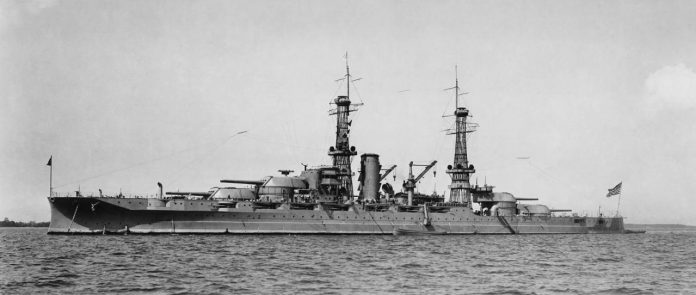
And so, Finally, we begin to describe the American "standard" battleships. As stated earlier, to compare with British Rivenjs"And German "Bayerns" American battleships of the "Pennsylvania" class were chosen - mainly, because of, that the ships of all three of these types were laid down almost simultaneously, at 1913 city, that is, they were designed and created at the same time. Besides, despite, that the first "standard" American battleship is "Nevada", she is, so to speak, there was still a "version-light".
Despite, that "Nevada" had all the features of a "standard" US battleship, that is, boilers for oil heating, an all-or-nothing booking scheme and the use of three-gun turrets (which the Americans were forced to abandon only on the "Marylands", since they were used on them already at 356 mm, and 406-mm guns), it was significantly smaller than "Pennsylvania" (about 4 000 t) and weakens armed. The next series of battleships, although they were larger than "Pennsylvania", but very insignificantly and, all the way to the Marylands, carried weapons of a similar composition.
The history of the design of battleships of the "Pennsylvania" class is very simple.. Despite, that the first American battleships, received 356-mm artillery, steel two ships of the "New York" type, the rest of their design solutions did not shine at all with novelty. Then the Americans began to design truly revolutionary battleships of the "Nevada", but, Unfortunately, the flight of design thought turned out to be pretty slowed down by financial constraints, which boiled down to the following: the newest ships should be "shoved" into the displacement of the previous type "New York".
The point was, that the creation of the American linear, and not only the linear fleet was highly dependent on the political situation in Congress and on the current attitude of the presidential administration to shipbuilding programs. The fleet wanted to lay on 2 battleship annually, but at the same time there were several years, when funds were allocated only for one ship of this class. But even in those cases, when Congress raised funds for the laying of two ships, he could insist on limiting their value, and in this respect American sailors and shipbuilders, perhaps, were in the worst conditions, than, eg, Germans with their "law of the sea".
So in the case of the "Nevada" admirals and designers had to make well-known sacrifices - so, the number of 356-mm guns had to be reduced from 12 to 10 guns. Some even suggested leaving everything 8 such guns, but the idea of building the latest battleships with weaker, than the ships of the previous series, did not find a positive response at all, even though, that the saved displacement was proposed to be used to enhance protection. Besides, the speed had to be reduced from the initial 21 with. to 20,5 with.
so here, when it's time to design the next series of superdreadnoughts, which eventually became the "Pennsylvania" -class battleships, American lawmakers are "generous", allowing you to increase the cost of building new ships from 6 to 7,5 million. Doll. Why is the word "generous" put in quotation marks?, after all, we are talking about as much as a 25% increase in funding? The thing is, what, At first, in fact, the cost of building "Nevada" and "Oklahoma" cost 13 645 360 Doll., or more than 6,8 million. Doll. per ship.
However, the actual cost of building "Pennsylvania" also exceeded the target, amounting to about 8 million. Doll. And secondly, the fact, that we are talking about the cost of construction, excluding armor and weapons: for two battleships of the "Nevada" type, the costs for these items amounted to 9 304 286 Doll. In other words, the total cost of "Nevada" was 11 401 073, 04 Doll., and "Oklahoma - and even more, 11 548 573,28 Doll. and permission to design and build "Pennsylvania" on 1,5 million. Doll. more expensive represented only an approximately 13 percent increase in the total cost of the ship.
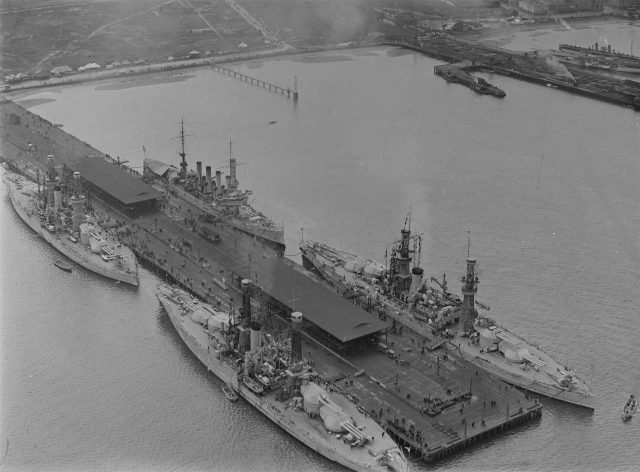
Linkor «Pennsylvania» (in the lower right corner) next to their predecessors: «Oklahoma» and «Nevada»
Need to say, that with this money the Americans managed to achieve quite a lot - in general, battleships of the "Pennsylvania" type looked more powerful and harmonious, than ships of the previous type. This is not surprising: in fact, main characteristics of "Pennsylvania" - 12 * 356-mm guns, speed 21 with. and protection at the level of "Nevada" are all that, what the admirals wanted to see in the project of battleships of the "Nevada" type, but which had to be partially abandoned, to "shove" battleships into the required displacement and size of the estimate.
Design
We will not describe in detail the vicissitudes of this stage of the creation of battleships of the "Pennsylvania" type., as they will be more relevant in the relevant sections, dedicated to artillery, armor protection and power plant of the ship. Let's dwell on just a couple of interesting general facts..
The US Navy had a real risk of getting two more Nevadas instead of "Pennsylvania". The thing is, that the General Council formulated its requirements for the "battleship 1913 Mr. " 9 June 1911 city, just as, when the Nevada project was almost ready. Not surprising, that the Bureau of Construction and Repair, responsible for design work, there was a great temptation to "sell" the newly made project again. There was even a tactical justification for this.: after all, the General Council itself pursued the line of building battleships by squadrons 4 ship, so why be wise? We take a ready-made project, we will finish a little here, darn there, and…
But the General Council reasoned perfectly sensibly - there is no point, having received expanded financial opportunities, build two more Nevadas, with all their weak points, resulting from a financial compromise. In the same time, battleships of the requirements stated by the General Council (12*356-mm, 22*127-mm, 21 node) quite capable of forming a tactical four with the "Nevada", although they will be somewhat stronger and more perfect than the last.
When the Pennsylvania design was in full swing, The General Council went to Congress with a proposal to build in financial 1913 g. as many as four such battleships. History is silent about, was it really serious intention, or just responsible persons, inspired by the proverb "You want a lot - you get little", seriously counted only on 2 link, leaving room for trade with congressmen. The fact is, that such vast appetites were deemed excessive, but most of all the program 1913 g. knocked down by the notorious senator Tillman, who wondered: why spend a lot of money on a series of gradually improving ships? Let's get down to the design and construction of the most powerful ultimate battleships right away., more and stronger than which at the current technological level it will be simply impossible to create.
According to Tillman, the logic of the development of naval weapons will still lead other countries to the construction of such battleships, that, of course, immediately obsolete all previous, and if so, then why wait? Generally, points of view were too contradictory, Congressmen did not have a common understanding of the future of linear forces, doubt ruled the show, and as a result in 1913 g. USA laid down only one ship - "Pennsylvania", and his "sistership" (strictly speaking, then you should have written "her") "Arizona" was founded only in the following, 1914 g.
Interesting, although this does not apply to the topic of the article, that in the United States, at the suggestion of Tillman, they did indeed conduct relevant research. The parameters of the "ultimate" battleship were amazing: 80 000 t, 297 m length, speed about 25 knots, armor belt in 482 mm, main caliber from 15 (!) 457-mm guns in five three-gun turrets or 24 * 406 mm in four six-gun turrets! However, the very first estimates showed, that the cost of one such ship will be at least 50 million. Doll., that is, about the same, how many divisions from 4 battleships of the "Pennsylvania" class, so the work on this topic was discontinued (although later resumed).
Artillery
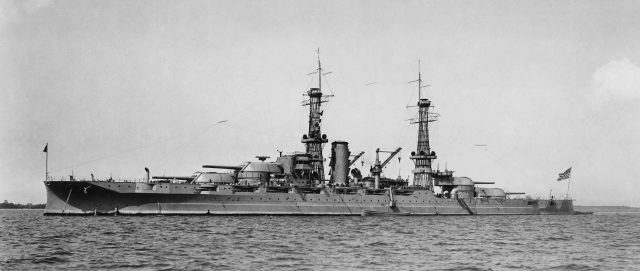
«Sistership» «Pennsylvania» - battleship «Arizona»
The main caliber of battleships of the "Pennsylvania", beyond all doubt, was the strangest sight among all the heavy marine installations in the world.
"Pennsylvania" and "Arizona" armed with 356-mm / 45 guns (true caliber - 355.6 mm) modifications Mk ... but which one, may be, Americans themselves do not remember, at least no precise data could be found in the Russian-language literature. The thing is, that these guns were installed on US battleships starting with "New York" and were modified a huge number of times: existed 12 main modifications of this gun, but "inside" they had others - they were designated from Mk 1/0 to Mk 12/10. At the same time, the differences between them, as a rule, were completely insignificant., for, perhaps, two exceptions. One of them concerned the initial series: the fact, that the very first 356 mm / 45 guns were not lined, but then, of course, got a laner. The second was produced after the First World War and consisted in an increase in the charging chamber., thanks to which the gun was able to fire a heavier projectile with a higher initial velocity.
Moreover, most modifications (but still not all) the ballistics of the guns remained identical, often the whole "modification" consisted only of, that the gun received a generally identical liner with a slightly modified manufacturing technology, and, as the liners were replaced, the gun "changed" its modification. Also, the appearance of new modifications could be caused by the modernization, or simply by replacing the completely shot gun, and I must say, what, especially in 20-30 the last century, the Americans drove their gunners quite intensively. This is how it turned out, that it was the norm for American battleships to have several modifications of guns on one ship at the same time. So, on the "Oklahoma" at the time of her death there were two guns Mk 8/0; five - Mk 9/0; one - Mk 9/2 and two more Mk 10/0.
Wherein, as we said above, the ballistic qualities of the modifications, with rare exceptions, remained unchanged. Nevertheless, the Americans did not shy away from putting guns with different ballistics on one ship - it was believed, that small deviations are quite capable of compensating for the fire control system. Idea, frankly, highly questionable, and, Need to think, it was still not widely practiced.
Generally, one side, updating the main caliber of US battleships looks more or less logical, but due to its confusion it is unclear, what modification guns did Pennsylvania and Arizona receive when they entered service?. It also creates a certain degree of uncertainty in their performance characteristics., because, usually, the corresponding data in the sources are given for modifications of the Mk 8 or Mk 12 - apparently, the Pennsylvania-class battleships originally had earlier models.
Usually, for 356-mm / 45 guns of American battleships such data is given: to 1923 city, when the next modification increased the chamber, allowing you to shoot a heavier charge, they were designed to fire 635 kg projectile with a muzzle velocity 792 m / sec. At an elevation angle of 15 city. the range of the shot was 21,7 km or 117 cable. In subsequent modifications (1923 g. and further) the same guns got the opportunity to shoot the latest, a heavier projectile weighing 680 kg with the same initial speed, or else, when using the old 635 kg of the projectile, increase its muzzle velocity to 823 m / sec.
Why do you need to describe in detail the situation with post-war modifications, because we, obviously, we will not take them into account when comparing battleships? This is necessary in order, so that dear reader, when, if he suddenly comes across certain calculations of the armor penetration of these 356 mm / 45 American guns, remembered about, that they can be performed precisely for a later, enhanced modification. So, eg, we can see the calculations, given in the book by A.V. Mandel.
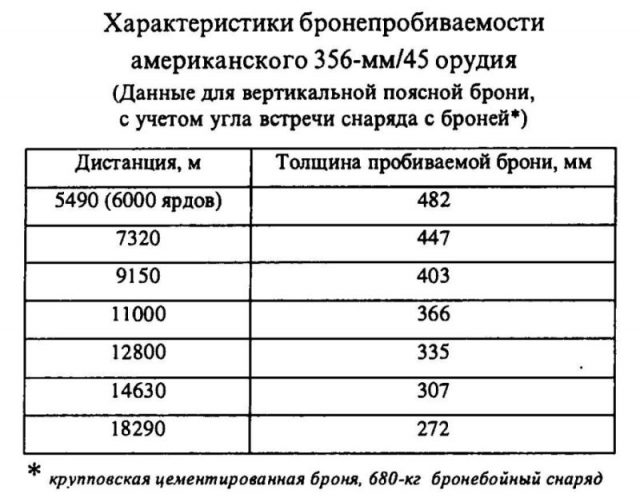
In this way, we see, What's on (roundly) 60 cable American cannon "mastered" 366 mm armor, and on 70 cable - 336 mm. This is clearly more modest than the British 381 mm gun., on tests pierced the frontal 350 mm armor plate of the tower of the German "Baden" at a distance of 77,5 to., but the footnote to the table states, that the given data were considered for 680 kg projectile. From which it obviously follows, what indicators 635 kg of projectile are even more modest. However, let's not get ahead of ourselves - a comparison of the artillery of German battleships, England and the USA we will do later.
The ammunition load of the Pennsylvania-class battleships was 100 shells on the barrel, it included ... exactly 100 armor-piercing shells. American admirals have long been confident, that their battleships are designed for one and only task: crushing your own kind at the extreme distances of the battle. In their opinion, an armor-piercing projectile was best suited for this purpose, and if so, then why litter the cellars of battleships with other types of ammunition? Generally, high-explosive shells on the "standard" 356-mm battleships of the United States appeared only to 1942 city, and there is no point in considering them in this series of articles.
As for 635 kg of armor-piercing projectile, then it was completed 13,4 kg of explosive, namely - data, later name: Explosive D. This explosive is composed of ammonium picrate. (not to be confused with picric acid, which became the basis for the famous Japanese shimosa, or liddita, melinite, etc.). In general, this American explosive had slightly less capabilities compared to TNT. (TNT equivalent 0,95), but it was much calmer and less prone to spontaneous explosion, than shimosa. Author of this Article, Alas, could not figure it out, was there any fundamental difference between the early versions of dannite and the later "D-Explosion", which were completed 680 kg shells: probably, if they were, then extremely insignificant.
Interesting fact: later 680 kg shell contained only 10,2 kg BB, that is, even less, what was in 635 kg. At all, It should be noted, that the Americans in their shells obviously "invested" primarily in armor penetration, strengthening the walls to the extreme, and correspondingly, ammunition strength, sacrificing a mass of explosive. Even in the "mighty" 635 kg projectile, the number of explosives corresponded, rather, his 305-mm "brothers": just remind, what 405,5 kg armor-piercing shell of the German 305-mm / 50 gun carried 11,5 kg BB, And russian 470,9 kg ammunition for a similar purpose - 12,95 kg. However, in fairness, note that the British 343-mm "greenboy", being a full-fledged armor-piercing projectile and having a mass similar to the American fourteen-inch projectile (639,6 kg), slightly exceeded the latter in explosive content - it contained 15 kg of shellite.
American 356 mm / 45 guns withstood 250 shots 635 kg projectile with a muzzle velocity 792 m / sec. Unimaginative, but not a bad indicator.
By design, the 356-mm / 45 artillery systems represented, so to speak, a kind of intermediate option between the German and British approaches. The barrel was of a fastened structure, like the Germans, but the lock was piston, like the british: the latter was to a certain extent dictated by the, that piston, downward opening shutter, It was, perhaps, the most optimal solution in a cramped three-gun turret. certainly, the use of advanced technology gave the Americans a good gain in the mass of the gun. Japanese 356-mm cannon of the battleship "Fuso", having a wire barrel structure and approximately equal muzzle energy, weighed 86 t, against 64,6 tons of the American artillery system.
In general, the following can be said about the American 356-mm / 45 gun.. For its time, and the first model of this gun was created in 1910 city, it was a very perfect and competitive artillery system, by far one of the best naval guns in the world. She was in no way inferior to the British and made in England for Japan 343-356-mm guns, and in some ways it exceeded. But with all this, the potential capabilities of this weapon were largely limited by the only type of ammunition - an armor-piercing projectile., which the, in addition, had a relatively low content of explosives. AND, of course, for all its merits, 356-mm / 45 gun in its capabilities with the latest 380-381-mm artillery systems could not compete.
On the other hand, Americans on battleships of the "Pennsylvania" class managed to place a dozen 356-mm / 45, while the ships of the types "Rivenge" and "Bayern" carried only 8 guns of the main caliber. For, to equip the battleship with so many barrels, without lengthening its citadel excessively, American designers used three-gun turrets, whose design ... however, first things first.
For the first time such towers were used on battleships of the "Nevada" type.: forced to "tamp" the ship into the displacement of the previous "New York", the Americans were very eager to reduce the size and weight of the three-gun turrets as much as possible, if possible bringing them closer to two-gun. Well, the Americans achieved their goal: the geometric dimensions of the towers differed little, So, the inner diameter of the barbette of the two-gun turret "Nevada" was 8,53 m, and three-gun - 9,14 m, and the weight of the rotating part is respectively 628 and 760 t. And this, It turned out, there was not yet a limit: battleships of the "Pennsylvania" type received towers, albeit of a similar design, but even smaller, their mass was 736 t, and the inner diameter of the barbet was reduced to 8,84 m. But at what cost was it achieved?
American twin turrets had a classic design, in which each tool is in a separate cradle and is supplied with its own set of mechanisms, providing the supply of shells and charges. In this respect, the two-gun turrets of the United States were quite similar to the installations of England and Germany.. But to miniaturize the three-gun turrets, American designers had to place all three guns in one cradle and confine themselves to two shell and charging lifts for three guns!
Interesting, what most sources indicate, that there were three charging lifts, so only the supply of shells "suffered", but, judging by the expanded (but alas!, not always clear) the description of the structure of the towers, given by V.N.. Chausov in his monograph "Battleships Oklahoma and Nevada", it's still not so. That is, in each American tower there really were two shell and three charging lifts., but the fact is, that one of the latter supplied charges from the cellars only to the reloading compartment, and from there, two other charging lifts supplied charges to the guns.
However, apparently, a single lift to the loading compartment did not create a bottleneck - it was a chain, and, probably, quite coped with its task. But in the tower itself, only the extreme guns were provided with shell and charging lifts. (first and third), the average did not have its own lifts - no charger, no shell.
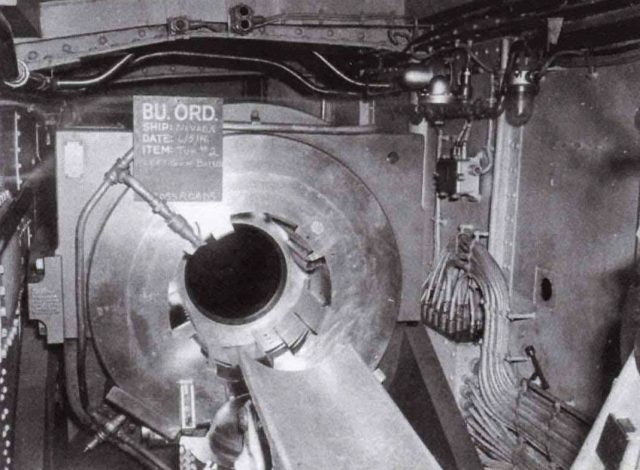
Breech 356 mm / 45 guns of the battleship «Oklahoma» in a two-gun turret.
Americans claim, that "with appropriate preparation of calculations" a three-gun turret can, basically, develop the same rate of fire, as the two-gun, but it's very hard to believe. The technological flaw described above does not in any way allow counting on a similar result with equal preparation of calculations of two- and three-gun towers. In other words, if the calculation of the two-gun turret is trained regularly, and a three-gun one - moreover, to chase into the tail and into the mane day and night, then maybe they will equalize in rate of fire per barrel. But this will be achieved solely through superior training., and if the same is given to the calculation of the two-gun turret?
Another extremely serious drawback of the American three-gun turrets was the low mechanization of their processes.. Main caliber guns of battleships of England, Germany and many other countries had fully mechanized loading, that is, the projectile, and charges, after feeding and to the guns, were fed into them by means of mechanical rammers. But not the Americans! Their rammer was used only when loading a projectile., but the charges were sent manually. How did this affect the rate of fire? Recall, that the charge for the 356 mm / 45 gun in those years was 165,6 kg, that is, for only one salvo, the calculation should have manually moved almost half a ton of gunpowder, and taking into account, that the Americans claimed the rate of fire in 1,25-1,175 rounds per minute…
Of course, loaders did not have to carry charges on their backs, they had to be rolled from the lift onto a special table, and then, at "zero" elevation angle of the gun, "Push" the charges into the chamber with a special wooden poker stick (either by hand). Generally, probably, minutes 10 at such a pace, a physically prepared person could withstand, what then?
Let's now return to the "excellent" solution of placing all three guns in one cradle.. In fact, the disadvantages of such a design are largely exaggerated and could be partially compensated for by the organization of the shooting., taking into account this feature. Which made it easier to do, using the then advanced "ledge" or "double ledge" sighting methods, but ... the problem is, that the Americans did nothing of the kind. And therefore, the disadvantages inherent in the "one-man" scheme manifested themselves on their battleships in all their glory.
Strictly speaking, in the "one-arm" scheme, besides compactness, there is at least one more advantage - the axes of the guns are on the same line, at that time, the guns in different cradles had a mismatch of the barrel lines, which was not so easy to fight. In other words, due to small backlashes, etc.. when installing guns, let us say, at an elevation angle of 5 city., it could turn out like this, that the right gun of the two-gun turret got the correct angle, and the left one is slightly smaller, and this, of course, affected the accuracy of fire. "One-sided" installations did not have such a problem, but alas!, this is their list of advantages and ends.
Regular towers (ie. having tools in different cradles) were able to fire incomplete volleys, that is, while one gun is aiming at the target and firing, the rest are charging. In this way, among other things, maximum fire performance is achieved, since no cannon of the tower is idle - at each moment of time it is either guided, either fires a shot, or drops to the angle of loading, either charging. In this way, delays can only occur "through the fault" of the fire controller, if the latter delays the transfer of data for firing to the guns. And if necessary, a battleship with 8 main battery guns with a rate of fire 1 shot at 40 seconds per barrel, capable of firing four-gun volleys every 20 seconds. Battleship with 12 with such weapons it is capable of firing three four-gun volleys every 40 seconds, that is, the interval between volleys is only a little more than 13 seconds.
But in the "one-arm" system, such performance is achieved only with salvo fire, when the towers fire a volley from all guns at once: in this case, a battleship with a dozen main battery guns will fire only one salvo at 40 seconds, but, if it's a full salvo, then they will go on a flight 12 shells, that is the same, how many will be released in three four-gun. But if you shoot with incomplete volleys, then the fire performance significantly sags.
But why shoot with incomplete volleys at all? The thing is, that when shooting "full board" only one type of zeroing is available - "fork", when to achieve, so that one volley lay in flight, second - undershot (or vice versa) and then "half" the distance until then, until coverage is reached. for example, shot 75 cable - flight, 65 cables - undershoot, shoot 70 cables and we are waiting, what will come of it. Let's, flight, then we set the sight on 67,5 cable, and here, likely, there will be a cover. this one good, but a slow way of sighting, therefore inquiring naval thought and invented the sighting "ledge" and "double ledge", when volleys are fired at different distances by a "ladder", and without waiting for the fall of the previous salvo.
for example, we shoot three volleys with a step 5 cable (65, 70 and 75 cable) with a small time interval between each salvo, and then we estimate the position of the target relative to several falls. Taking into account a number of nuances of sea shooting, similar sighting, although, perhaps, and leads to an increased consumption of projectiles, but it allows you to cover the target much faster, than the traditional "fork".
But if the "one-arm" battleship tries to shoot with a double ledge (at intervals, for example, 10 seconds between volleys), then he will release 12 shells not for 40, and for 60 seconds, since the waiting time between the first and second and the second and third volley of the gun will be idle. In this way, the commander of the American battleship had to choose between fire performance, or modern shooting methods. The choice was made in favor of fire performance - and before, and on time, and for a long time after the First World War, the US line fleet was fired on with full volleys. In fairness it should be noted, that this was not a consequence of the "one-man" towers - the Americans just thought, that at long distances of the battle it will be more convenient to adjust the shooting according to the falls of full volleys.
However, firing full volleys presented other complications., which, surprisingly, on their own, the Americans simply did not notice. As we said, The "one-sided" scheme has a potential advantage over the classical one in accuracy due to the absence of misalignment of the axes of the trunks, but in practice it can be realized only when firing incomplete volleys. But with full volleys, dispersal, conversely, sharply increases relative to the classical scheme due to the close arrangement of the axes of the trunks, and the effects of expanding gases, escaping from the trunks, on projectiles flying out of neighboring guns. So, for the two-gun turrets of the battleship "Oklahoma" the indicated distance was 2,24 m, and the three-gun only 1,5 m. on the teachings, after the volleys of the three-gun turrets, American sailors sometimes observed collisions (!) the shells they fired in flight.
Nevertheless, the problem was not recognized, but was taken for granted, and so it went on until then, until the USA at the end of World War I sent their dreadnoughts to support Great Britain. of course, American ships and based, and trained with the English, and it was here that the admirals of the United States realized that, that the dispersion of shells in the salvoes of British battleships is much less, than the American - and this applied to US ships with two-gun turrets!
Eventually, in the United States created a special device, introducing a small delay of the guns of one tower in a salvo - they fired with a time difference 0,06 sec. Usually mentioned, that the use of this appliance (first installed on US ships in 1918 g) allowed to achieve a decrease in scattering by half, but in fairness, it was not possible to do with one device. So, on the battleship "New York" in order to reduce dispersion at the maximum firing range (Alas, not specified in cable) from 730 to 360 m had, in addition to delaying the shot, also reduce the muzzle velocity of the projectiles - and again, not reported, to what extent. That is, the accuracy, which means that the accuracy of American guns was improved, but, including due to some drop in armor penetration.
A rhetorical question: if similar difficulties with dispersal had relatively good two-gun turrets of the Americans, what happened to the three-gun?
Nevertheless, a number of authors, eg, such, as Mandel A.V., taken to argue, that the disadvantages of the towers of American battleships were mostly theoretical and did not manifest themselves in practice. In support of this point of view, eg, the results of test firing of the battleship "Oklahoma" for 1924/25 year…
But we will talk about this in the next article..
To be continued…
/Andrew from Chelyabinsk, topwar.ru/











